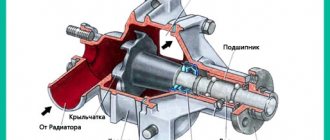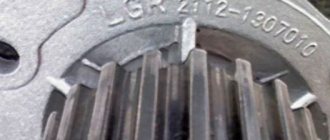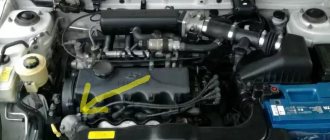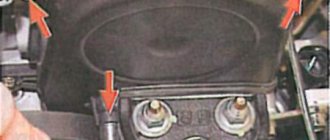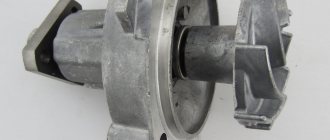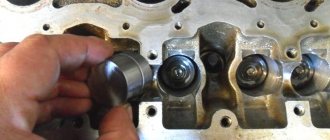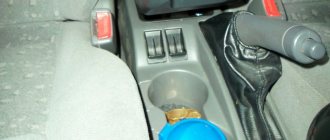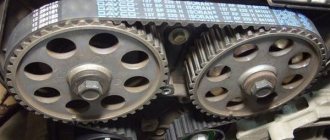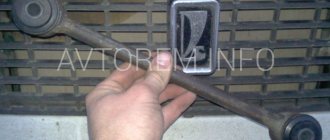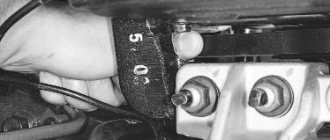Purpose and design of the pump
The pump (water pump) provides forced circulation of coolant (coolant). Its functions are similar to those of a gasoline pump that supplies fuel.
It's structured quite simply. The housing contains an impeller (blades) and a shaft rotating on bearings. The shaft receives torque from the engine through the belt - therefore, a malfunction of the pump leads to rapid overheating of the motor.
The pump is based on an impeller and a shaft with bearings
Symptoms of device malfunction are as follows:
- noise or whistling of an extraneous nature;
- the arrow on the engine temperature scale (to the right of the speedometer on the dashboard) is in the red zone;
- traces of coolant are visible under the car and on the pump itself;
- there is a smell of coolant in the cabin;
- a sharp decrease in the level of antifreeze in the coolant tank;
- play in the pulley that rotates the pump.
The main manufacturers of original pumps for the KIA Spectra:
- SKF (Switzerland);
- Graf (Italy);
- Airtex (Spain);
- Ruville and LUK (Germany).
When purchasing a new pump, you should always pay attention to the presence of a sealing gasket in the kit. If it is not there, the product is not original.
When replacing a water pump, always install a new gasket
How to change the alternator belt on a Kia Rio?
A driver who knows how to replace a belt on a Kia Rio need not be afraid of accidentally stopping the car on the highway due to a broken part. Replacing it yourself will take a little time and will help avoid evacuation of the vehicle to the nearest service station.
Along with the belt, the tension and support rollers will need to be replaced at the same time.
Belt replacement work is carried out in the following order:
- open the hood;
- remove the negative terminal from the battery;
- Unscrew the bolt securing the generator to the tension bar;
- remove the adjusting screw with nut;
- we move the generator to the cylinder block;
- remove the belt from the pulleys;
- install the new one in reverse order;
- connect the battery.
There is also a way to remove the belt from below, for example, when you change the oil and park the car on an overpass. To do this, you need to slightly press the tension roller (the nut on the roller itself, not below) using a lever and remove the belt. Put on the new belt and tighten the pulley.
A fairly simple task of replacing a part on a Kia Rio will help restore the car’s performance in an emergency. Since the procedure is carried out quickly, car enthusiasts always have a belt in stock. But do not confuse the alternator belt with the timing belt.
If your alternator belt has failed, then you can get to the car service center on one battery charge, and if the timing belt has failed, you can end up with expensive engine repairs. It is best to carry out vehicle maintenance before long trips.
Many owners of KIA Rio 2011-2016,
on a not warmed up car, they hear an unpleasant creaking noise from under the hood
, which disappears after a few minutes. In this article we will look at the reasons for the appearance of this sound and ways to get rid of it.
What makes a squeak (whistle) under the hood of a KIA Rio
An example of a squeak (crunch) from the tensioner pulley bearing in the video.
ACCESSORY BELT
The sound produced by the drive belt will be more like a whistle; its appearance is primarily associated with wear or contamination of the belt. During operation, the belt gradually stretches by several millimeters; in addition, sand, dirt, and water get under it.
Checking the belt is not difficult; to do this, we need to pour water on it before starting the car. Next, we start the car and if the whistle disappears, then we change the belt. Accessory belt
It is a consumable, so it cannot be replaced under warranty. However, you can make the replacement yourself, and purchase the belt yourself in the store.
Drive belt catalog number - 252122B000
. You can choose according to characteristics - marking 6 PK 2137
(six strands, length 2137 mm). The approximate cost of the original is 900 rubles.
Trying to clean an old belt or using belt conditioner is not very effective. Do not attempt to clean it yourself; this is done with the engine running and there is a high risk of serious injury.
AUTOMATIC TENSIONER
The sound when the tensioner wears out is more like a bearing crunch and squeak. The problem is the roller bearing. The creaking appears on a cold engine in damp weather; when the car warms up, the sound gradually disappears. There are different repair options.
— If the car is under warranty, then feel free to go to the official tensioner
they should replace it under warranty. Many will argue about dirt and condensation, while simply blowing air, this measure is temporary (if it helps, of course).
If, when replacing the tensioner at an official KIA service center, you are offered to change the belt, and even if it is in good condition, agree. Because replacing a belt separately from the tensioner will cost more than a new belt.
— If RIO is no longer under warranty, then the tensioner
you can change it yourself; if there is an overpass, the replacement can be done in 1-2 hours. Since it is automatic, you don’t need to adjust the tension yourself, which greatly simplifies the task.
Automatic tensioner number
according to the catalog - 252812B010
(cost 5000 rubles).
— To save money, you can replace the bearing in the roller. The roller is equipped with
6203 GMB
bearing . The roller is steel, so you can safely press in a new bearing without damaging it. The issue price is about 200 rubles. However, in some cases, replacing the bearing may not help due to deformation of the tensioner housing or when the spring is severely weakened.
It is worth noting that in rare cases, the sound may come from the bearings of the generator, air conditioning compressor or pump - this happens much less often.
Hello. We will replace the alternator belt on the Kia Rio 3, and also simplify the belt tensioning system.
First, I’ll tell you about simplifying belt tension. The manufacturer installed a tensioner that has a short service life (two or three belt replacements). The price of such a tensioner is about 8 thousand rubles. Other Korean cars, for example the Hyundai Elantra, do not have such an expensive tensioner; everything is done there to adjust the tension manually. The generator on the Elantra is secured with a bracket on which the adjustment is realized.
It turned out that this bracket fits perfectly with the mounts on the Rio 3. This means it can be converted to a simple tension adjustment system and get rid of an expensive spare part. To remodel you need to buy a bracket with a bolt.
After the conversion, you will only change the belts during vehicle maintenance. There is nothing to wear out in the adjustment itself; it will last the entire life of the car.
Tools: wrench, heads for twelve and fourteen.
Replacing the pump on a KIA Spectra
Most experts do not recommend changing the pump yourself. However, experienced car owners do it themselves without any problems.
Location
On a KIA Spectra, the pump is located near the cylinder head.
The KIA Spectra pump is located in a place that is not very convenient for dismantling
To gain access to the pump, it is necessary to remove the alternator and timing belts.
Before replacing, it is recommended to thoroughly clean the pump seat
Car service
In branded stores, an original pump cannot cost less than 3 thousand rubles. Analogues can be purchased for a much smaller amount - from 1 thousand rubles.
The cost of car service services when replacing a mechanism without removing the timing belt is estimated from 2 thousand rubles, and with removing the timing belt - from 4.5 thousand rubles. A three-month guarantee is provided. All work takes no more than 2–3 hours.
Draining antifreeze
When replacing, it is recommended to completely renew the coolant; the new pump will not be able to work correctly with the old coolant. The liquid is drained into a container with a volume of at least 5 liters. Fresh antifreeze is poured in a volume equal to the volume of the drained coolant.
Required Tools
To replace you will need the following tools:
- set of wrenches;
- socket head with extended knob;
To unscrew deeply located bolts, a socket head with an extended wrench is required
Belts are dismantled using a special tool
Using a universal pry bar, the pump pulley is removed
Replacing the pump without removing the timing belt
In order to replace the water pump without removing the timing belt, you must perform the following steps.
- The wheel is removed, the engine protection is unscrewed and the plastic fender liner is detached.
To access the pump it is necessary to remove the engine protection
When replacing the pump, the timing belt protection is removed
The water pump pulley is removed using a pry bar.
Before removing the belts, it is recommended to take photos with different positions of the camshafts. When standing in front of the hood, mark I of the left camshaft pulley should be level with mark E of the right camshaft. In order to correctly align the camshafts, you should turn the crankshaft one revolution.
When installing belts, the camshaft marks must be at the same level
Changing the pump on KIA Spectra cars, which require removal of the timing belt, is extremely difficult. In this case, it is advisable to immediately contact a car service center.
Video: replacing the KIA Spectra pump
Replacing the water pump on a KIA Spectra with your own hands is quite simple. All you need to do is carefully follow the recommendations of professionals.
Replacing the Kia Spectra timing belt
The history of cars goes back many years, because the first carriages with gasoline engines appeared in 1885. Since then, machines have gradually become increasingly important in human life, to the point where they have now become an integral part of it. Modern cars are much more complex than their predecessors and consist of approximately 15-20 thousand different parts, among which the most important ones stand out, on which, one might say, the car’s ability to move rests. These include a timing belt or chain.
One of the mandatory maintenance procedures for the Kia Spectra is timely replacement of the timing belt , which has a direct impact on engine performance. And it is recommended to replace it as early as possible, in order to avoid breakage, and therefore more serious damage, approximately every 60,000 - 80,000 kilometers.
| Type of work | Deadline | Price |
| Replacing the timing belt | from 1500 rub. | |
| Replacing timing chains | from 3000 rub. | |
| Replacing service belts and rollers | from 1000 rub. | |
| Replacing rollers, pumps and seals |
*All prices are for informational purposes only. A more accurate price can be found at the service station after diagnosis.
In what other case is it necessary to visit the service?
If you bought a new car and its mileage is close to the numbers when it is necessary to change the timing belt, then everything is clear here. But if you purchased a used car, then you need to make sure that everything is in order with the timing chain or belt. To do this, you can assess the condition of the belt using certain characteristics:
- Oil stains appeared on its surface
- Delamination became noticeable at the ends
- The presence of various irregularities - dimples, bulges, folds, cracks, etc.
- Characteristic whistle when the engine is running
If you notice that there is something wrong with the timing belt/chain, you should immediately visit a car service center where experienced specialists will diagnose and replace parts.
In addition to replacing the chain or belt, experts recommend immediately replacing the pump, rollers and seals to prevent possible problems.
Kia Spectra service at Autobahn service center
Repairing a Kia Spectra car is always a complex procedure that requires special skills, extensive experience and special equipment, and therefore it is better to entrust it to specialists who know their job very well. The Autobahn service station employs real professionals who will carry out diagnostics and repairs quickly and efficiently. We guarantee reliability and optimal prices, which are formed according to the most understandable scheme. We provide our clients with a detailed estimate that gives a complete picture of what you are paying for. Trust the professionals, because cars are literally our life, and we will make sure that your “iron horse” continues to rush you along the roads!
Kia Spectra repair
- Model: Kia Spectra SD
- Body type: sedan
- Year, mileage: 2006, 143,000 km
- Gearbox, drive: manual, front
- Engine: 1.6 petrol
Reason for contacting the Kia Spectra auto service center “Auto-Mig”:
- Kia Spectra pump replacement
- coolant leak from under the engine
Diagnostics revealed the following:
- The cooling pump has failed. For the owner of this car, this was not very pleasant news, since when replacing the pump on a Kia Spectra, the timing belt must be removed, which increases the cost of the work. And the timing belt on this car was changed only 1000 km ago. If the pump is replaced together with the timing belt, this will significantly reduce the cost of repairs.
Completed work:
- Removing and installing the timing belt
- pump replacement
- adding coolant
Quick replacement of the timing belt for a Kia Spectra with a 1.6 engine and automatic transmission
Today an old Kia Spectra came to us to replace the timing belt, rollers and all technical fluids. The replacement procedure will take approximately 45 minutes and will not require any special devices or incredible skills of an auto mechanic.
- Replacement interval
- Necessary tools and preparatory work
- Replacement procedure
- Crankshaft lock
- Installing a new timing belt
- Video of replacing the Kia Spectra timing belt
Replacement interval
All instructions recommend changing the timing belt at 60,000 kilometers, but somewhere I’ve come across 45,000. We recommend changing the timing belt at 40, 45 thousand kilometers, since we all know very well the quality of our spare parts.
Attention! If the timing belt breaks, all valves are turned.
Necessary tools and preparatory work
To work, we will need a set of socket heads, spanners and one and a half liters of mineral water.
We block the rear wheels with wheel chocks, remove the front right wheel and crankcase protection. Disconnect the negative terminal of the battery. Let the engine cool down.
Replacement procedure
Remove the decorative engine cover. Unscrew the four bolts on the 10th upper timing cover.
Upper timing belt cover.
Unscrew the tension bolt of the power steering pump and remove the power steering belt. Somehow I photographed it poorly, it didn’t turn out very clear.
Power steering belt tensioner.
Next, before you remove the alternator belt, loosen the three #10 bolts securing the pump pulley.
Fastening the pump pulley.
We loosen the locking bolt by 13 and the tension bolt by 10 and, moving the generator, remove the generator belt. Then remove the pump pulley.
Alternator belt tensioner.
Crankshaft lock
We lock the crankshaft, in the case of an automatic transmission, by inserting a specially trained screwdriver into the flywheel.
If you have a mechanic, you can lock the crankshaft by engaging fifth gear by inserting a screwdriver into the ventilation holes of the brake disc in the caliper area.
Attention! Never unscrew, much less tighten, the crankshaft bolt using the starter.
Unscrew the crankshaft bolt and the four bolts securing the pulley.
Fastening the crankshaft pulley.
Unscrew the four ten bolts securing the lower timing belt cover.
Fastening the lower timing belt cover.
Well, and two more bolts of the middle timing cover.
Fastening the middle timing belt cover.
Set the top dead center. To do this, temporarily tighten the crankshaft bolt and rotate it, always clockwise until the marks on the camshaft sprockets and the rear timing cover match.
Intake camshaft mark.
Exhaust camshaft mark.
Accordingly, the mark on the crankshaft sprocket should coincide with the mark on the oil pump.
Crankshaft mark.
Loosen the bolt 13 of the timing belt tension roller and remove the belt.
Fastening the tension roller.
Please note that the timing belt is tensioned using a spring.
Tension spring.
Remove the tension and deflection rollers. We install new rollers, tighten the bypass bolt, and simply tighten the tension bolt. Don't forget about the spring. It’s convenient for me to install it right away; some people install it after installing the belt.
New timing kit.
Installing a new timing belt
We check that all marks match, then install a new timing belt in the following sequence: crankshaft sprocket, idler pulley, camshaft sprockets, tension roller.
Don't forget about the direction of rotation!
We check that all the branches of the belt are tensioned and the marks do not run away, and tighten the tension roller. We turn the crankshaft two turns and check the marks again.
We install all parts in the reverse order of removal. Everything is very simple.
Video of replacing the Kia Spectra timing belt
Kia Spectra pump replacement
Parts used:
- 25100-2X200 — Kia Spectra cooling system pump
Consumables used:
- antifreeze for Kia Spectra
The cost (price) of replacing a Kia Spectra pump can be clarified by an auto repair shop technician or in the QUESTIONS AND ANSWERS section
Kia Spectra. Engine cooling pump malfunctions
To ensure the circulation of liquid in the cooling system of a car engine, a centrifugal pump, or pump, is used. It can have a mechanical or electrical drive type. If the pump is faulty, the entire cooling system will be inoperative, leading to engine overheating.
Possible malfunctions of the pump (centrifugal pump) of the cooling system
A failure of the coolant pump can lead to the shutdown of the entire system. This can seriously affect the condition of the engine. The most common pump problems are:
- Wear of the seal (oil seal). In this case, a coolant leak occurs.
- Breakage of the impeller. When the impeller is destroyed, fluid injection becomes worse (pressure drops) or stops altogether.
-Bearings jamming. If the pump's lubrication deteriorates, which can also be a consequence of leaking coolant, the pump begins to operate intermittently.
-Increasing play between the impeller and the pump shaft. During operation, the impeller attached to the shaft may become loose, which leads to unstable operation of the pump and other breakdowns.
-Chemical corrosion. Most often, this problem affects the pump impeller and occurs if low-quality fluids are used.
-Destruction due to cavitation. Air bubbles that may arise during operation of the pump intensively destroy it from the inside, which leads to fragility of parts and their damage by corrosion.
- System contamination. Chemical deposits and simply dirt that gets inside the pump over time form a hard coating on its parts, which makes it difficult for the impeller to rotate and the passage of liquid.
-Destruction of bearings. In this case, a characteristic whistle appears when the pump operates. It is difficult to replace such bearings, and therefore in this case the pump is simply replaced.
- Broken drive belt. If a low-quality belt is used or is not replaced in a timely manner, rupture or slippage may occur.
Signs of a pump malfunction
- Extraneous noises. Often, a partially faulty cooling system water pump produces “unhealthy” noisy or “howling” sounds when operating. They can be caused by significant wear of the bearing and/or the fact that the pump impeller touches the pump body when rotating. This also occurs due to partial bearing failure.
- Play in the pump pulley. It occurs due to damage or natural wear of its rotation bearing. Diagnostics in this case can be carried out quite simply, just shake the pump shaft from side to side with your fingers. If there is any play, it will be tactilely felt. Please note that the formation of play brings closer the moment when the pump seal will become leaky and will leak coolant.
-The appearance of a leak. So, antifreeze can leak both from the seal and from other places, for example, the housing and impeller. Antifreeze or antifreeze in this case can be seen on the pump body, its mounting location, some elements of the engine compartment under the pump (depending on the design of a particular car) or simply on the ground under the car.
-An antifreeze smell appears. In particular, it can be felt not only in the engine compartment (when the hood is opened), but also in the cabin, since its fumes will enter the cabin through the ventilation system. Antifreeze has a sweetish smell, sometimes with a taste of alcohol.
-Misalignment of fastening. In particular, in relation to timing gears, as well as tension rollers. This can be seen visually, or by placing some flat object (for example, a ruler) in the same plane as the rollers and pump. In this case, a situation often arises when the belt eats up.
- Significant increase in engine temperature. And not only the engine, but also the coolant, as indicated by the warning light on the dashboard. In critical cases, a banal boiling of antifreeze occurs, and steam will come out of the radiator. However, this is critical and if it occurs, it is prohibited to use the car!
How to determine if your pump is faulty
Checking your car's engine water pump for faults is quite simple. The simplest method is to try by touch to see if there is any play or no play on the pump shaft. To do this, just grab the pump shaft with your fingers and pull it from side to side in a direction perpendicular to the shaft itself (that is, across). If the bearing is in order, then there should be no play. If even a slight play occurs, then the pump needs to be replaced.
However, a more thorough check without removing the pump is performed using the following algorithm:
- Warm up the engine to operating temperature. That is, so that the coolant temperature is around +90°C. -With the engine running, hand pinch the thick pipe with coolant that comes from the radiator. -If the pump is working properly, then pressure should be felt in it. If there is no pressure or it is pulsating, then this means that the pump is partially or completely out of order. Most likely the pump impeller has turned.
Please note that the temperature of the coolant, and therefore the pipe, is quite high, so you need to work carefully; you can use gloves or rags. Also, to check the pump, you need to visually inspect its seat. To do this, you need to dismantle the protective casing of the gas distribution mechanism in order to gain access directly to the pump (the design is different for different cars, so perhaps there will be no casing or it does not need to be removed). Next, carefully inspect the pump body, its seal and seat.
You definitely need to pay attention to the presence of antifreeze leaks from under the sealing gasket. Moreover, it does not have to be wet at the time of testing. If the seat and seal are dry, but there are dried (and fresh) traces of leaks in the mounting area, this means that at high pressure the seal still allows coolant to pass through. Traces of leaks have a reddish or brownish-brown color, in some cases gray (this depends on what color antifreeze was poured into the cooling system).
You also need to inspect the location where the pump adheres to the engine block. Ideally, there should be no coolant leaks from the drain hole. However, if there are minor leaks, then you can not change the pump, but temporarily try to get rid of them by replacing the seal and using sealant.
To check whether it is the pump bearing that is making the corresponding noise and whistle, just remove the belt from the pump pulley and unscrew it by hand, preferably as quickly as possible.
If the bearing is faulty, it will make a hum and roll with a noticeable rumble and unevenly. However, this method is suitable for those pumps whose pulley is rotated by a drive belt. If it is rotated by a timing belt, then for diagnosis it will be necessary to weaken its force and check its operation under such conditions.
contents .. 201 202 203 204 ..
Replacing the Kia Spectra 1.6 Pump
Timing belt kia range: standalone replacement
The gas distribution mechanism in modern cars is driven from the crankshaft using a chain or belt drive.
Kia spectra
The Kia Spectra was launched in 2000, replacing the previous Kia Sephia brand. In Korea, the model operated under the Mentor brand in 1999-2000 and was released in America by 2004. It should be noted that the car on the South American market was supplied in two bodies:
- 5-door hatchback;
- 4 door car.
The Korean brand Kia Spectra was produced at the Izhevsk Automobile Plant from 2005 to 2011 and exclusively in the body of a car. In 2009, production of Spectra in Izhevsk ended, but in order to fulfill all its obligations to the Korean company, IzhAvto was obliged to produce a small batch of cars in the summer of 2011.
Kia Spectra 1.6 Timing
Izhevsk Kia Spectra was equipped with only one type of engine - a 1.6-liter gasoline unit (S6D). As promised, I am publishing my report on pump replacement, ›pump replacement and 1.6L, 101L. C. Replacing the Kia Spectral pump. Pump replacement for Kia Seed, Optima, Sorento, Spectrum and Picanto. This is a 4-cylinder in-line 16-valve engine (4 valves per cylinder) with a displacement of 101 liters. With.
Kia Timing Composition Spectrum 1.6 includes:
- two camshafts, they are located in the cylinder head;
- 16 valves;
- intermediate roller;
- tension roller;
- belt;
- two gears;
- crankshaft.
The timing belt, in addition to the camshafts, is also driven by the water pump.
When to change dates
The timing belt has its own resource; according to the manufacturer’s recommendation, it should be replaced every 45 thousand kilometers (TO-3). Most likely, the Izhevsk plant is reinsured, but it is better not to delay replacement, and the belt should be changed approximately every 60 thousand km.
At each maintenance, it is necessary to check the condition of the timing belt and inspect the tension rollers. Car owners should be aware that if the belt breaks or if it bites several teeth, it is likely that the valve in the cylinder head will become bent. So the question of when to change the deadline is always open - if you think the belt is already on, it's better to get the job done without returning the case in the dark.
How to check deadlines
Buy a timing belt, pump (water pump) and replacement rollers for a Kia Spectra
Kia Spectra Izhevsk 1.6 l. from 2000 to 2011
Buy a timing belt from 2003 to 2011
24312-2X000 — timing belt
MOBIS original. Quality 100%!
1 987 949 558 — timing belt
BOSCH The supply of spare parts to automakers' conveyors and their sale to the secondary market accounts for 70% of the company's turnover. BOSCH spare parts are very popular in many countries, both among professionals and among car enthusiasts.
24410-2X701 — timing belt tension roller
MOBIS original. Quality 100%!
GT20050 - timing belt tension roller
GMB (Japan) is the world's largest manufacturer of water pumps, propeller shaft joints (crosspieces), and timing belt tensioner rollers.
24810-2X700 — timing belt calming roller
MOBIS original. Quality 100%!
GT-20060 — timing belt calming roller
GMB (Japan) is the world's largest manufacturer of water pumps, propeller shaft joints (crosspieces), and timing belt tensioner rollers.
MOBIS original. Quality 100%!
PARTS MALL are exporters and manufacturers of high quality Korean auto parts for the entire range of Hyundai and Kia cars.
25124-2X000 — pump gasket
MOBIS original. Quality 100%!
0K30E-12-711 — timing tension spring
MOBIS original. Quality 100%!
Buy a timing belt from 2000 to 2003
0K30E-12-205 — timing belt
MOBIS original. Quality 100%!
1 987 949 558 — timing belt
BOSCH The supply of spare parts to automakers' conveyors and their sale to the secondary market accounts for 70% of the company's turnover. BOSCH spare parts are very popular in many countries, both among professionals and among car enthusiasts.
24410-2X700 — timing belt tension roller
MOBIS original. Quality 100%!
GT-20050 — timing belt tension roller
GMB (Japan) is the world's largest manufacturer of water pumps, propeller shaft joints (crosspieces), and timing belt tensioner rollers.
24810-2X700 — timing belt calming roller
MOBIS original. Quality 100%!
GT-20060 — timing belt calming roller
GMB (Japan) is the world's largest manufacturer of water pumps, propeller shaft joints (crosspieces), and timing belt tensioner rollers.
MOBIS original. Quality 100%!
PARTS MALL are exporters and manufacturers of high quality Korean auto parts for the entire range of Hyundai and Kia cars.
KB621-15-116B - pump gasket
MOBIS original. Quality 100%!
0K30E-12-711 — timing tension spring
MOBIS original. Quality 100%!
Related parts:
Check out our recommendations for selecting spare parts:
Didn't find the spare part you need in the catalog?
Call us and we will:
or call us: +7
North of Moscow
Basket
- Authorization
- Registration
- Request by VIN
- Kia Ceed
- Kia Sportage
- Kia Sorento
- Kia Rio
- Kia Picanto
- Kia Soul
- Kia Venga
- Kia Optima
- Kia Mohave
- Kia Quoris
- Kia Stinger
- Kia Seltos
- Kia K5
- Kia Cerato
- Kia Spectra
- Kia Carens
- Kia Carnival
Replacing the pump on a Kia Spectra, how to change it yourself + video » AvtoNovator
I changed the timing belt at 45 thousand.
I compared the new Kia Spectra, replacing the pump and rollers with the old ones - no difference. The old ones are in almost better condition. I agree, but the schedule for replacing the timing belt used to be 90 thousand. I checked the pump at the same time - there is no play, and it spins tightly, there are live bearings. When examined when removed, the condition of the Kia Spectra is replacement of the pump with a new one. To remove the casing, you need to unscrew four nuts.
To remove the decorative casing, you need to unscrew the four nuts. Draining the coolant Since the pump is located at the bottom of the engine, to replace it you need to drain all the coolant from the cooling system.
Typically, antifreeze is completely changed every two years. If the specified period has approached or the antifreeze has changed its color, and sediment has appeared in the expansion tank, fresh coolant is added when replacing the pump. Many coolants contain ethylene glycol, which is harmful to health and the environment.
Removing the Kia Spectra Pump – Video
Replacing the water pump and timing belt
After this, the generator mounting bolts are tightened. In this case, clean containers should be used to drain and temporarily store antifreeze.
Is it possible to pour motul eco-nergy 5w into Spectra? Next Engine operation step by step during the repair process...
The tension of the power steering belt is adjusted in the same way. The mounting bracket of the decorative casing is removed. To remove the mudguard, unscrew the three fastening bolts. The right half of the mudguard is removed in the same way.
Before adding antifreeze, make sure that the coolant drain valve at the bottom of the radiator is closed, and that the lower hose is attached to the fitting and secured with a clamp. But before removing the timing belt, I decided to take a couple of photographs with different positions of the camshafts, the one above shows the position of the marks by which I set it, and this is incorrect.
Remove the generator and water pump drive belt, see “Generator and water pump belt”. Remove the three bolts securing the pulley to the water pump flange, securing it from turning with a screwdriver, as shown in the photo. Remove the timing belt, see “Timing Belt.” After removing the timing belt, do not rotate the camshaft and crankshaft, as the pistons may damage the valves.
Loosen the clamp securing the hose to the water pump nozzle by squeezing its bent ears with pliers, slide the clamp along the hose and disconnect the hose. Unscrew the two bolts securing the pipe to the water pump housing. Through the cooling system, the heat released during combustion of the fuel-air mixture in the engine is absorbed by the radiator. On a KIA Spectra, the pump and generator are driven by the crankshaft pulley through a poly-V belt.
Rotation of the impeller is ensured by sealed bearings pressed into the pump housing.
Lubrication of bearings during operation is not required. Replacing the water pump of a KIA Spectra car. Replacing the pump is necessary when obvious signs of its malfunction appear: If in these cases the pump is not replaced, it can completely collapse and cause serious engine damage.
The KIA Spectra water pump cannot be repaired and must be replaced as an assembly. The cost of a new pump depends on the manufacturer. The price of the original part for the KIA Spectra, depending on the article, is 3.2-5.5 thousand. The price of analogues starts from 1.6 thousand. Location of the pump The KIA Spectra pump is located in the right-hand direction of the lower part of the front wall of the cylinder block.
To ensure free access to it, it is necessary to remove the drive belts of the power steering, generator, pump and crankshaft pulleys and the timing belt protective cover. The pump is located in the right-hand direction of the lower part of the front wall of the cylinder block. Necessary tools To remove and replace the pump you will need: Procedure for replacing the water pump It is more convenient to change the pump in an inspection hole or overpass. The engine must be cold.
Before starting work, disconnect the ground wire from the battery and remove the decorative protective casing from the engine. To remove the casing, you need to unscrew four nuts.
To remove the decorative casing, you need to unscrew the four nuts. Draining the coolant Since the pump is located at the bottom of the engine, to replace it you need to drain all the coolant from the cooling system.
Typically, antifreeze is completely changed every two years. If the specified period has approached or the antifreeze has changed its color, and sediment has appeared in the expansion tank, fresh coolant is added when replacing the pump.
Replacing the timing belt and cooling water pump on a kia spektra
Many coolants contain ethylene glycol, which is harmful to health and the environment. Therefore, pouring antifreeze onto the ground is not recommended.
You should first prepare the container, drain the coolant into it and dispose of it. If the coolant resource has not yet been exhausted, it can be poured back into the system after replacing the pump. In this case, clean containers should be used to drain and temporarily store antifreeze.
The procedure for draining antifreeze from the cooling system is as follows. The plug is removed from the expansion tank.
To drain the coolant, you must first remove the expansion tank cap. Remove the radiator filler cap. The radiator filler plug is removed. In the lower right part of the radiator in the direction of travel there is a tap for draining the coolant.
To reduce liquid losses when draining, a tube of the appropriate diameter is put on the drain valve fitting. The other end of the tube is directed into a container prepared in advance with a volume of at least five liters. The tap opens and the coolant drains from the radiator. To drain the coolant from the radiator, open the tap. For convenience, remove the plastic splash guard, which protects the lower part of the engine from dirt and consists of two parts.
Replacing the water pump of a KIA Spectra
To remove the left half, use a Phillips screwdriver to unscrew the clamps, and the three fastening pistons are removed from their sockets. The mudguard is attached using plastic pistons. The middle piston is removed.
After removing the clamps, the fastening pistons are removed by hand. The rear piston is removed. After removing the pistons, the left side of the mudguard is removed. Using a 10mm wrench, unscrew the three bolts securing the mudguard.
The left side of the mudguard is removed.
Self-diagnosis and replacement of the water pump of a KIA Spectra
Therefore, pouring antifreeze onto the ground is not recommended. You should first prepare the container, drain it into a kia spectra coolant pump replacement and dispose of it. If the coolant resource has not yet been exhausted, it can be poured back into the system after replacing the pump. In this case, clean containers should be used to drain and temporarily store antifreeze. The procedure for replacing the antifreeze drain pump in the Kia Spectra is as follows. The plug is removed from the expansion tank.
To drain the coolant, you must first remove the expansion tank cap. Remove the radiator filler cap. The radiator filler plug is removed. In the lower right part of the radiator in the direction of travel there is a tap for draining the coolant.
To reduce liquid losses when draining, a tube of the appropriate diameter is put on the drain valve fitting. The other end of the tube is directed into a container prepared in advance with a volume of at least five liters.
The tap opens and the coolant drains from the radiator. To drain the coolant from the radiator, open the tap. For convenience, remove the plastic splash guard, which protects the lower part of the engine from dirt and consists of two parts.
To remove the left half, use a Phillips screwdriver to unscrew the clamps, and the three fastening pistons are removed from their sockets. The front piston is removed.
The mudguard is attached using plastic pistons. The middle piston is removed. After removing the clamps, the fastening pistons are removed by hand. The rear piston is removed. After removing the pistons, the left side of the mudguard is removed. Using a 10mm wrench, unscrew the three bolts securing the mudguard. The left side of the mudguard is removed.
Water pump Kia Spectra / Kia Spectra (IZH)
EASY WITH KIA SPECTRA - SPECTRAVODA DIARY (entry seventh - pump)
The engine must be cold. Old spark plugs, with some huge gaps... Well, what can I say after the work done.
KIA Spectra Operation and Repair Manual. 2. Remove the alternator and water pump drive belt...
To do this, with the tension roller mounting bolt loosened, rotate the crankshaft twice. Assembly is carried out in reverse order. On a KIA Spectra, the pump and generator are driven by the crankshaft pulley through a poly-V belt.
Replacing the Kia Spectrum pump and I promised to post my report on replacing the pump, and at the same time I adjusted the timing belt last time, as many said, I really made a mistake by 1 tooth. Adjust the tension of the generator and water pump drive belts, see “Generator and water pump belt”. Its functions are similar to those of a gasoline pump that supplies fuel.
To access the pump, it is necessary to remove the engine protection. Remove the belts from the generator and power steering. When removing the generator belt, two bolts are loosened - the bolt attached to the tension bar and the bolt attached to the engine bracket. The belt tension is reduced by rotating the adjusting tensioner.
The cover covering the timing belt is removed from the engine. When replacing the pump, the protection from the timing belt is removed. The antifreeze is drained.
Kia Spectra pump replacement
If work is carried out on a warm engine, protective equipment should be used. Use a pry bar to remove the water pump pulley. An assistant will be needed for this. The car is put in fifth gear, the assistant presses the brake pedal.
To prevent the pulley from turning, the mount rests against the pulley nut with one end and against the body with the other. The pulley mounting bolt and the pulley itself are removed. The water pump pulley is removed using a pry bar. The pump is removed. A new device with gasket is installed. To remove the middle timing belt cover, unscrew the fastening bolt. The middle cover is removed.
After unscrewing the fastening bolt, the middle timing belt cover is removed. Using a 21 wrench, unscrew the bolt in the center of the crankshaft pulley. To prevent the crankshaft from turning, it is fixed. To do this, engage fifth gear and simultaneously hold down the brake pedal.
The crankshaft pulley mounting bolt is unscrewed with a 21 key. The crankshaft pulley is removed.
After unscrewing the fastening bolt, the pulley is removed. Three bolts securing the lower part of the timing belt cover are turned out. The bolts securing the bottom cover are unscrewed. The bottom cover is removed.
The lower timing belt cover is removed from the engine. Using pliers, the tension roller spring is removed. The tension roller spring is removed using pliers. The fastening bolt is pressed out, and the tension roller is moved to the side. The tension roller is moved to the side. The timing belt is removed. After removing the timing belt, do not allow the crankshaft and camshafts to rotate. Changing their relative position can lead to malfunctions and engine damage.
Removing the pump When removing the pump, it is recommended to follow the following procedure: Use pliers to compress and move the fixing clamp, and the hose is disconnected from the pump nozzle.
